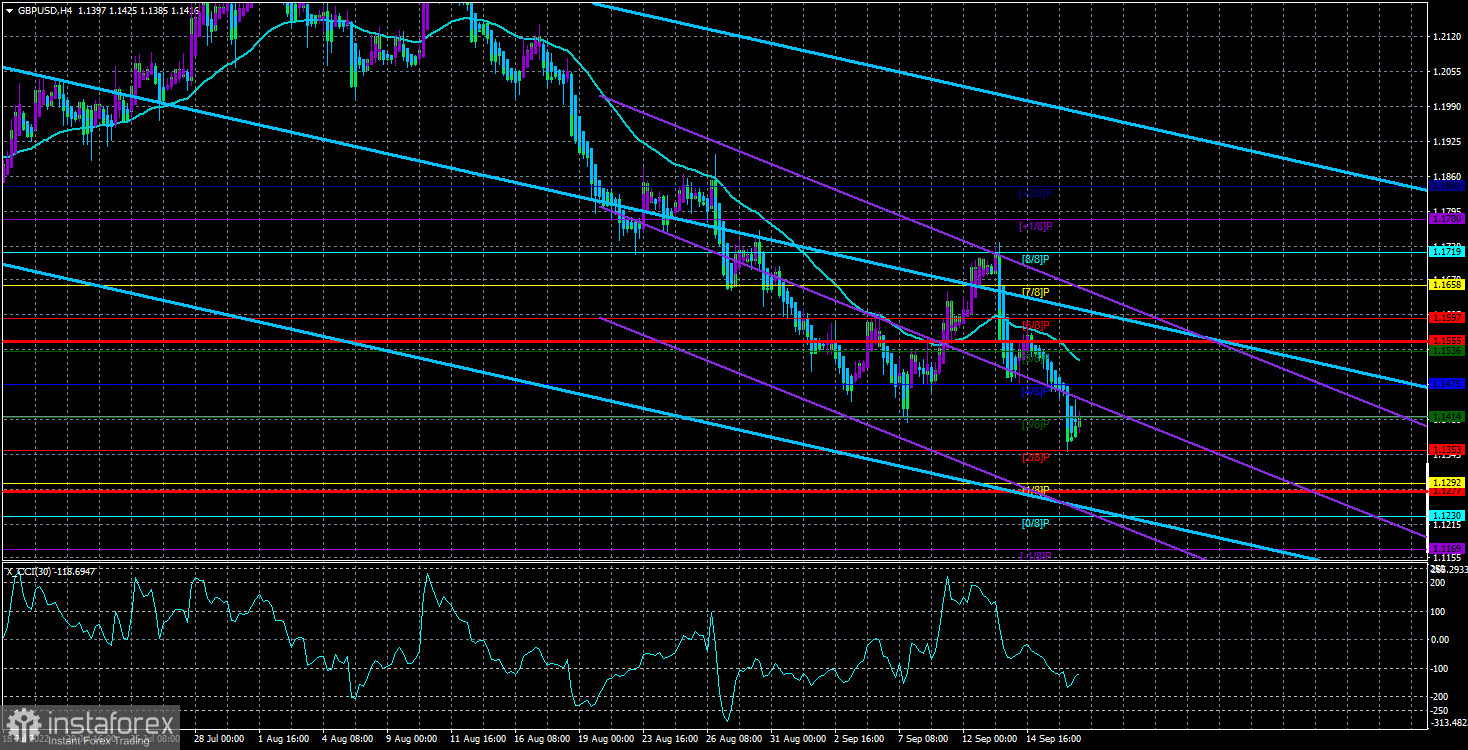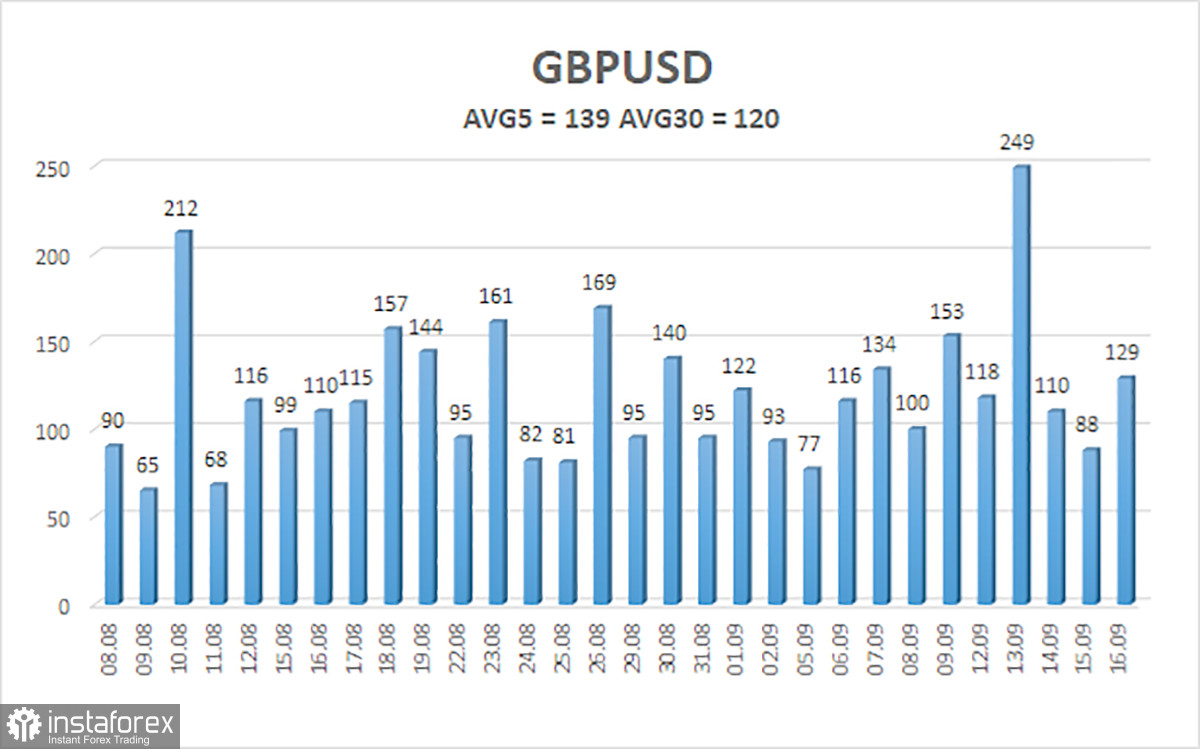
The GBP/USD currency pair continued to trade lower over the past week. After the last upward spurt, the pound sterling returned to the positions it had been trading in recent weeks and even renewed its lows for 37 years. They are located near the 14th level, and the price cannot normally adjust, which says only one thing: most traders remain in sales. As in the case of the euro currency, the fundamental background may begin to change in favor of the pound, which may provoke the completion of the global downward trend in several months. But is it worth talking about it now? Yes, the "foundation" is gradually leveling off, but this does not mean that the market is already ready to complete its massive pair sales, which it perfectly demonstrated last week. Both linear regression channels continue to be directed downward. The CCI indicator entered the oversold area a month ago, but this did not provoke strong growth. Everything suggests that the minimums will be updated at least once more.
Separately, I would like to say that the British statistics last week (from our point of view) were "moderately neutral," if I may say so. It should be understood that forecasts do not always come true, and the deviation of one indicator by 0.1-0.2% cannot be considered critical. What have we seen this week? GDP grew by 0.2% in July, which is generally in line with forecasts. Industrial production decreased by 0.3%, which is much lower than forecasts, but this is not the most important indicator. But unemployment has decreased from 3.8% to 3.6%, which in some ways frees the hands of the central bank, which is very much afraid of a recession, mass layoffs, and bankruptcies. Wages rose in line with forecasts, and inflation unexpectedly fell for the first time in a year and a half. Only retail sales were significantly below forecasts. We would say things are not as bad in the UK as one might assume.
Nevertheless, all the attention is on the Bank of England and the Fed.
However, all these seemingly not-so-bad statistics pale before two events this week. The Bank of England will choose between raising the rate by 0.5% and 0.75%. The Fed will hesitate between raising the rate by 0.75% and raising it by 0.75%. And it seems that the Fed's decision will be the most important for the market. It is worth recalling again that the Bank of England raised the key rate six times in a row, but it did not help the pound sterling in any way. Only if the British regulator dares to increase by 0.75% can we expect the pound to strengthen. And then, how long will it last if the Fed also raises the rate by 0.75%?
As unfortunate as it may sound for the pound, it now needs serious support factors, which are not yet observed. In Britain, the prime minister has just been replaced, and the country is on the verge of recession. Queen Elizabeth II has died, inflation is off the scale, energy prices are rising, and the burden on the budget and households is increasing. All this gives no reason for traders to buy British currency at the expense of a much more stable and strong dollar. And suppose we also recall the "Northern Ireland protocol," friction with the European Union, a possible referendum in Scotland, the consequences of Brexit, and the coronavirus pandemic. In that case, it becomes clear why traders desperately do not want to deal with the pound. In any case, it will be possible to count on an uptrend for the pair only if there are strong buy signals. And on the 24-hour timeframe, the price could not even reach the critical line, from which, for example, the euro currency bounced. Since the correlation between the euro and the pound is still high, we would say that the pound's fall will continue.

The average volatility of the GBP/USD pair over the last five trading days is 139 points. For the pound/dollar pair, this value is "high." On Monday, September 19, we expect movement inside the channel, limited by the levels of 1.1277 and 1.1555. A reversal of the Heiken Ashi indicator upwards will signal a round of upward correction.
Nearest support levels:
S1 – 1.1353
S2 – 1.1292
S3 – 1.1230
Nearest resistance levels:
R1 – 1.1414
R2 – 1.1475
R3 – 1.1536
Trading Recommendations:
The GBP/USD pair continues to roll down on the 4-hour timeframe. Therefore, at the moment, you should stay in sell orders with targets of 1.1353 and 1.1277 until the Heiken Ashi indicator turns up. Buy orders should be opened when fixed above the moving average with targets of 1.1597 and 1.1658.
Explanations of the illustrations:
Linear regression channels – help determine the current trend. If both are directed in the same direction, then the trend is strong.
Moving average line (settings 20.0, smoothed) – determines the short-term trend and the direction in which trading should be conducted now.
Murray levels are target levels for movements and corrections.
Based on current volatility indicators, volatility levels (red lines) are the likely price channel in which the pair will spend the next day.
The CCI indicator – its entry into the oversold area (below -250) or into the overbought area (above +250) means that a trend reversal in the opposite direction is approaching.





















